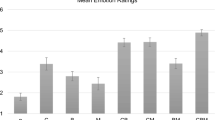Various investigators have proposed that people may feel simultaneous positive and negative affect. However, experimental evidence from tests of a recent theory about the intensity of emotion (J. W. Brehm, 1999) suggests that even when they are invited by the experimental design, positive and negative emotions do not occur at the same time. When people have been instigated to feel a particular emotion, such as happiness, and then are given a reason (e.g., sad news) for not feeling happy, they report continued happiness but no increase in sadness unless the reason for feeling sad is very great, in which case sadness replaces happiness. The present paper briefly reviews the underlying theory and evidence, and discusses implications.







Similar content being viewed by others
Notes
Dr. Joseph Dien.
References
Brehm, J. W. (1999). The intensity of emotion. Personality and Social Psychology Review, 3, 2–22.
Brehm, J. W., Brummett, B. H., & Harvey, L. (1999). Paradoxical sadness. Motivation and Emotion, 23, 31–44.
Brehm, J. W., & Miller, K. (1999). The effect of deterrents on affect. Unpublished manuscript. University of Kansas.
Brummett, B. H. (1996). The intensity of anger. Unpublished doctoral dissertation, University of Kansas.
Cacioppo, J. T., & Berntson, G. G. (1999). The affect system: Architecture and operating characteristics. Current Directions in Psychological Science, 8, 133–137.
Cacioppo, J. T., Gardner, W. L., & Berntson, G. G. (1997). Beyond bipolar conceptualizations and measures: The case of attitudes and evaluative space. Personality and Social Psychology Review, 1, 3–25.
Cacioppo, J. T., Gardner, W. L., & Berntson, G. G. (1999). The affect system has parallel and integrative processing components: Form follows function. Journal of Personality and Social Psychology, 76, 839–855.
Cacioppo, J. T., Larsen, J. T., Smith, N. K., & Berntson, G. G. (2004). The affect system: What lurks below the surface of feelings? In A. S. R. Manstead, N. H. Frijda, & A. H. Fischer (Eds.), Feelings and emotions: The Amsterdam conference. New York: Cambridge University Press.
D’Anello, S. C. (1997). Paradoxical effects of losing money and experiencing a health threat on happiness intensity. Unpublished doctoral dissertation, University of Kansas.
de Gelder, B., & Vroomer, J. (2000). The perception of emotion by ear and eye. Cognition and Emotion, 14, 289–311.
Diener, E., & Emmons, R. A. (1985). The independence of positive and negative affect. Journal of Personality and Social Psychology, 47, 1105–1117.
Diener, E., & Iran-Nejad, A. (1986). The relationship in experience between different types of affect. Journal of Personality and Social Psychology, 50, 1031–1038.
Goldstein, M. D., & Strube, M. J. (1994). Independence revisited: The relation between positive and negative affect in naturalistic setting. Personality and Social Psychology Bulletin, 20, 57–64.
Hamilton, V. (1983). The cognitive structures and processes of human motivation and personality. Chichester, England: Wiley.
Henriques, J. B., & Davidson, R. J. (1990). Regional brain electrical asymmetries discriminate between previously depressed subjects and healthy controls. Journal of Abnormal Psychology, 99, 22–31.
Larsen, J. T., McGraw, A. P., & Cacioppo, J. T. (2001). Can people feel happy and sad at the same time? Journal of Personality and Social Psychology, 81, 684–696.
Larsen, J. T., McGraw, A. P., Mellers, B. A., & Cacioppo, J. T. (2004). The agony of victory and thrill of defeats. Psychological Science, 15, 325–330.
Miron, A. M., Parkinson, S. K., & Brehm, J. W. (in press). Does happiness function like a motivational state? Cognition and Emotion.
Priester, J. R., & Petty, R. E. (1996). The gradual threshold model of ambivalence: Relating the positive and negative bases of attitudes to subjective ambivalence. Journal of Personality and Social Psychology, 71, 431–449.
Schimmack, U. (2005). Response latencies of pleasure and displeasure ratings: Further evidence for mixed feelings. Cognition and Emotion, 19, 671–691.
Schimmack, U., & Colcombe, S. (1999). Mixed feelings: Toward a theory of pleasure and displeasure, Unpublished manuscript, http://www.erin.utoronto.ca/∼w3psyuli/ms/mixed feelings.pdf
Silvia, P. J., & Brehm, J. W. (2001). Exploring alternative deterrents to emotional intensity: Anticipated happiness, distraction, and sadness. Cognition and Emotion, 15, 575–592.
Thompson, M. M., Zanna, M. P., & Griffin, D. W. (1995). Let’s not be indifferent about (attitudinal) ambivalence. In R. E. Petty & J. A. Krosnick (Eds.), Attitude strength: Antecedents and consequences (pp. 361–386). Mahwah, NJ: Erlbaum.
Tomarken, A. J., & Keener, A. D. (1998). Frontal brain asymmetry and depression: A self-regulatory perspective. Cognition and Emotion, 12, 387–420.
Watson, D. (1988). The vicissitudes of mood measurement: effects of varying descriptors, time frames, and response format on measures of positive and negative affect. Journal of Personality and Social Psychology, 55, 128–141.
Watson, D., & Tellegen, A. (1985). Toward a consensual structure of mood. Psychological Bulletin, 98, 219–235.
Watson, D., Wiese, D., Vaidya, J., & Tellegen, A. (1999). The two general activation systems of affect: Structural findings, evolutionary considerations, and psychobiological evidence. Journal of Personality and Social Psychology, 76, 820–838.
Author information
Authors and Affiliations
Corresponding author
Rights and permissions
About this article
Cite this article
Brehm, J.W., Miron, A.M. Can the Simultaneous Experience of Opposing Emotions Really Occur?. Motiv Emot 30, 13–30 (2006). https://doi.org/10.1007/s11031-006-9007-z
Published:
Issue Date:
DOI: https://doi.org/10.1007/s11031-006-9007-z



